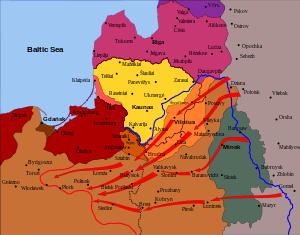Socialist Soviet Republic of Byelorussia

The Socialist Soviet Republic of Byelorussia or Soviet Socialist Republic of Belarus (SSRB; Belarusian: Савецкая Сацыялiстычная Рэспублiка Беларусь, Savieckaja Sacyjalistyčnaja Respublika, Belarusian Arabic alphabet: صاويَࢯقايا صاࢯِيالِصطِچنايا رَصپُبلِقا; Russian: Социалистическая Советская Республика Белоруссия / ССРБ, Socialističeskaja Sovetskaja Respublika Belorussija / SSRB) was an early republic in the historical territory of Belarus after the collapse of the Russian Empire as a result of the October Revolution.
First establishment
The first time it was established by Bolsheviks on January 1, 1919 in Smolensk when the Red Army entered Belarusian lands following the retreated German army, which had been occupying the territory as a consequence of World War I. The SSRB replaced Belarusian People's Republic.
The head of the state was Zmicier Zhylunovich (a Belarusian writer better known as Ciška Hartny, later repressed by Joseph Stalin). It consisted of Smolensk, Vitebsk, Mogilev, Minsk, Grodno, and Vilna governorates.
It was considered by Bolsheviks to be a buffer republic. In a month it was disbanded. Smolensk, Vitebsk and Mogilev provinces were included in the Russian Soviet Federative Socialist Republic (RSFSR), and the remainder formed another buffer republic, the Lithuanian–Belorussian Soviet Socialist Republic (Litbel).
Second establishment
The republic was re-established under the same name on July 31, 1920. However, in traditional Soviet historiography it has been referred to as the Byelorussian Soviet Socialist Republic (BSSR), its name after the incorporation into the Soviet Union in 1922.
A number of Bolsheviks strongly opposed the re-establishment of SSRB arguing that there is no Belarusian nation, that the Belarusian language is a dialect of Russian language, and that Belarusian culture is identical to Russian culture.
Eventually, the SSRB was re-established as a political move in the context of the Polish-Soviet War, in a minuscule territory of 52,400 km² made of 6 uyezds of Minsk Governorate. The rest of the Belarusian lands remained split between Poland and the RSFSR.